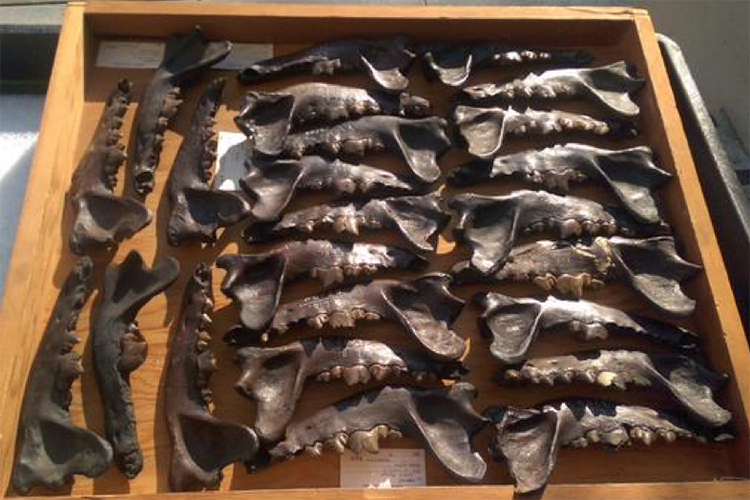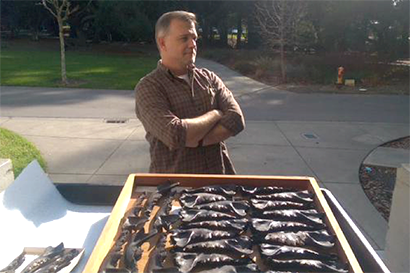Campanile bones hold climate-change clues
For more than 100 years, the tower has housed prehistoric fossils from the La Brea tar pits. Now climate-change researchers are finding them a priceless source of information.

August 17, 2015
Like Sleeping Beauty, slumbering in a castle for 100 years, some 20 tons of fossils have spent more than a century in UC Berkeley’s bell tower, the Jane K. Sather Campanile. Behind locked doors and in dim and dusty rooms, the prehistoric objects, excavated in the early 1900s, appear forgotten.
But more sought after than Princess Aurora, these ice age remains from Southern California’s Rancho La Brea tar pits are being roused each year by dozens of North American researchers, many of them in search of clues to a present-day crisis — global climate change.

Julie Meachen, who teaches anatomy at Des Moines University, first did research with the Campanile fossils as a UCLA Ph.D. student. (Photo by Robin O’Keefe)
Nearly 12,000 years ago, at the end of the last ice age, mammals including giant bison, mammoths, mastodons, American lions, dire wolves and saber-toothed cats went extinct as Earth warmed. So far, evidence points toward a combination of natural planetary warming and hunting by humans.
Today’s dilemma isn’t identical, but experts see a similar pattern in both time periods that involves climate change, human activity and the demise of animals.
“The fossils in the Campanile, and down in La Brea, are unique, and the story they have to tell is important,” says Robin O’Keefe, an anatomy professor at Marshall University in West Virginia who’s traveled to Berkeley since 2005 to analyze the bones. “The amount of research on this time period — the end of the Pleistocene — has skyrocketed, and by carbon-dating the fossils, measuring them, putting together big data sets, we as scientists hope to see how the ecosystem was being stressed.”
O’Keefe and Julie Meachen, an assistant professor of anatomy at Des Moines University in Iowa, have preliminary research findings showing that climate change altered the physical traits and shortened the life of Smilodon fatalis, the saber-toothed cat.
“People need to know that the Rancho La Brea fossils might hold the secret to the Pleistocene extinctions, and subsequently to what’s happening in modern times,” says Meachen. “They have endless potential, and need to be kept in perpetuity.”
Putting Berkeley on the map
Assembling important collections of minerals, fossils and mollusks was a priority for UC’s earliest faculty members, including geologist, naturalist and botanist Joseph LeConte, who arrived at Berkeley in 1869, and John Merriam, a student of LeConte’s who helped found Berkeley’s Department of Paleontology and went on to train many of the state’s most famous early California paleontologists.

UC-led excavations at the Rancho La Brea tar pits in Southern California began in 1905. (Photo courtesy UC Museum of Paleontology)
They led excavations from Yellowstone National Park to Mongolia, acquired and traded collections around the world, wrote journal and popular magazine articles about their discoveries, and attracted brilliant students to their new intellectual center.
“At the time, California was not terribly well-known, and these individuals wanted to make a name for the university, to put the West Coast on the map,” says Pat Holroyd, a senior museum scientist at the UC Museum of Paleontology. “There was a huge bias toward the collections of Harvard and Yale and Columbia, where people felt ‘the real science’ was going on.”
Berkeley teams unearthed unique skeletons of extinct species including Hydrotherasaurus, or “water beast lizard,” in Fresno County; Desmostylus, a relative of the sea cow, along the Pacific Coast; and, in Shasta County, Thalattosaurus, or “ocean lizard.” And at Rancho La Brea, in prehistoric Los Angeles, a massive graveyard of ice age creatures was found in crude oil that long had been seeping to the surface from fissures in Earth’s crust. Beginning in 1905, Merriam and his crews were among the first scientists to excavate there, and by 1913, they’d extracted the remains of more than 200 vertebrate species.
Packed in wooden crates and shipped by train to campus, the bones first were stored in California Hall’s basement. But in 1914, a year before the Campanile was completed, they were moved to the tower because of its ample storage space — the bones occupy five levels — and proximity to the paleontology department in nearby Bacon Hall.
The size of the Rancho La Brea collection today is second only to that at the George C. Page Museum in Los Angeles. And the UC Museum of Paleontology has one of the largest paleontological collections associated with a teaching university in the world.
Old bones, new directions
By the late 1930s, many of the tower’s ancient fossils had been cleaned, identified at least to a general level and cataloged, but then went relatively untouched for about 50 years. “Students were using them for comparative studies,” says Holroyd, “but no one was forging new research directions.”
The fossils were reorganized and inventoried by a student team from 1990 to 1993. Then, in the early 2000s, fossil species’ diets and tooth growth rates were studied by researchers with a new tool, stable isotope analysis. Awareness of the bones jumped in 2006 when the museum’s award-winning database went online. Today, about 100 researchers a year examine the fossils, and climate change is a growing focus.
Eric Holt, a Berkeley graduate student and part of the Barnosky Lab, which uses the fossil record to examine the effects of environmental change, is studying the La Brea collection to determine the geographical movements of wolf and coyote populations during times of environmental stress. Holt became intrigued with the bones as an undergraduate in a work study job at the museum.
“Understanding how ice age canids responded to climate change and to each other, and to changes in their available prey, is important,” says Holt, “since preserving species richness and diversity today may require human intervention.”
Meachen and O’Keefe are measuring fossils from various Rancho La Brea excavation pits to see how animals’ body shapes changed over time. They’ll then correlate the data with the climate record.
“These pits are snapshots of whatever was happening at the moment,” says Meachen. “In one particular pit excavated by Berkeley folks, number 2051, the fossils are between 21,000 and 30,000 years old – and those are the only La Brea fossils we have from that time.”
Early findings indicate that Smilodon became more specialized in its body form and mode of killing as the weather warmed and the animals it hunted began to disappear, she says. The cat grew larger, its teeth lengthened, and it killed more swiftly with its forearms. “But it damned itself to extinction even more,” adds Meachen, “since it couldn’t survive when the prey it became more specialized to kill went extinct.”
Wanted: Better housing
During 2015, the centennial year of the iconic Campanile, the UC Museum of Paleontology is focused on finding ways to improve housing for the Rancho La Brea fossils so they can remain useful to researchers for the next 100 years.
“Only 20 percent of the bones are stored the way you’d want them to be,” says Holroyd. Many are on open wooden shelves built in the 1920s, gathering dust and, occasionally, growing mold. Some need to be professionally organized and are stacked in cardboard boxes. Cabinets housing a small fraction of the remains were designed for animal skeletons and skins, not heavy fossils, and are difficult to open and do not seal.
“The lack of climate control in the tower subjects the fossils to fluctuations in temperature and humidity that ultimately make these thousands-of-years-old bones fall apart,” adds Anthony Barnosky, a Berkeley professor of integrative biology, calling the collection “a treasure trove of information about the prehistory and history of California.”

Student Eric Holt uses UV radiation from the sun to kill mold growing on some of the Campanile’s dire wolf fossils. (Photo by Sarah Tulga)
Adds Larisa DeSantis, a UC Berkeley alumna and an assistant professor of earth and environmental sciences at Vanderbilt University in Tennessee, “It’s challenging to find certain specimens, and without proper curation, it’s also hard to reference them in peer-reviewed publications.” She, too, uses the Rancho La Brea collection to explore how mammals responded to past climate and says she considers the fossils “critical keys to the past that are of relevance to modern conservation.”
“The Campanile is likely a good long-term home for them” because they are so numerous, says DeSantis, “but better storage facilities would go a long way to help protect them.”
The museum is making incremental improvements and actively seeking funds. A recent grant from the Institute of Museum and Library Services is allowing campus fossils from the McKittrick and Maricopa tar seeps near Bakersfield to be cleaned, curated and rehoused.
Berkeley faculty members like Leslea Hlusko, an integrative biology professor, help by improving the conditions of the fossils as they conduct research and use them as teaching tools.
But Mark Goodwin, assistant director of collections and research at the museum, says it will take much more — $400,000 to $500,000 — to bring the Campanile fossil collections up to museum standards.
“Not only are there fossils from La Brea and other California tar seeps in the tower,” he says, “but also assorted vertebrate fossils from the Age of Dinosaurs, exhibit and teaching casts, and invertebrate, paleobotanical and micropaleo collections. It falls on us as stewards of these collections to better preserve them.”